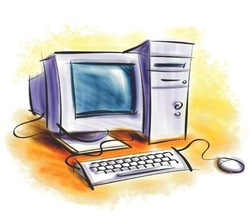First Generation of Computer
First Generation of mordern computer (1946 - 1954)
The period of first generation was 1946 - 1954. Computers of first generation used vacuum tubes as the basic components for memory and circuitry for Central Processing Unit.The first electronic computer, ENIAC (Electronic Numerical Integrator and calculator) was developed in 1947 at the University of Pennsylvania, USA. This machine had vacuum tubes as switching devices. Von Neumann introduced the concept of stored program by around the same time and the first digital computer using program, EDSAC (Electronic Delay Storage Automatic Calculator), was announced in 1949.
They were very large in size, consumed lot of power dnd emitted too much of heat. They required to be housed in large air-conditioned rooms.
During this period, computer programming was mainly done in machine language. The user had to be both an electronics expert and a programmer to use the computer for any task.

Advantages of First Generatin of Computer
» These computers fast and could calculate data in millisecond.
» Vacuum tubes were the only electronic component available during those days.
» Vacuum tube technology made possible to make electronic digital computers.
» Easily available and inexpensive.
» Tactile sensitivity is preserved.
» Color-coded for easier and faster identification of readings.
Disadvantages of First Generatin of Computer
» The computers were very large in size.
» They consumed a large amount of energy.
» They heated very soon due to thousands of vacuum tubes.
» They were not very reliable.
» Air conditioning was required.
» Constant maintenance was required.
» Non-portable.
» Costly commercial production.
» Costly commercial production.
» Limited commercial use.
» Very slow speed.
» Limited programming capabilities.
» Used machine language only.
» Used magnetic drums which provide very less data storage.
Example of First Generation of Computer
1. ENIAC (1946)
2. EDSAC (1949)
3. EDVAC (1950)
4. UNIVAC-1 (1951)
Other generation of computer
2. Second Generation of Computer (1955 - 1964)
3. Third Generation of Computer (1965 - 1974)
4. Fourth Generation of Computer (1975 - 1989)
5. Fifth Generation of Computer (1990 onwards)
